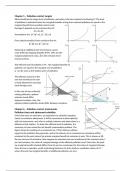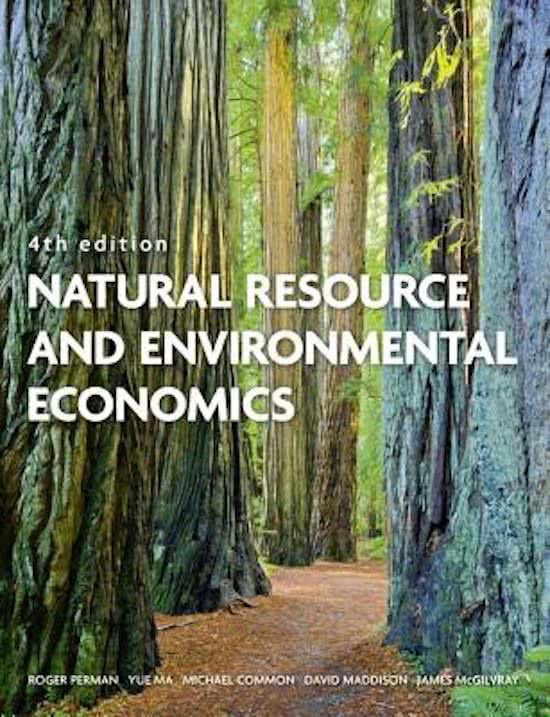Chapter 5 – Pollution control: targets
What should be the target level of pollution, and what is the best method of achieving it? The level
of pollution is optimized when the marginal benefits arising from reduced pollution are equal to the
marginal benefit from avoided control costs.
Damage D depends on the emission flow M:
D=D ( M )
Assumptions are: D ( M ) >0 , D' ' ( M ) >0
'
Firms obtain benefits B from emission flow M:
' ''
B ( M ) >0 , B ( M )< 0
Reducing an additional unit of emissions causes
costs (MAC) by forgoing benefits B’(M). MAC are the
marginal abatement costs, ^M is the emission level
chosen by firms.
The efficient level of pollution is M*, the marginal benefits of
pollution are equal to the marginal cost of pollution.
¿
μ can be seen as the shadow price of pollution.
The efficient outcome is the
one that minimizes the sum
of total abatement costs plus
total damage costs.
In the case of non-uniformly
mixing pollutants, optimal
emission levels differ
between locations. Also, the
optimal ambient pollution levels differ between receptors.
Chapter 6 – Pollution control: instruments
Pollution taxes and abatement subsidies
Given that taxes on emissions are equivalent to subsidies (negative
taxes) on emissions abatement, it will be convenient to deal explicitly
with tax instruments, and refer to subsidy schemes only when there is a
difference that matters. To attain the efficient level of pollution, it is
necessary to have solved the net benefit maximisation problem. The
figure shows the working of an emissions tax. If firms behave without
regard to the pollution they generate, and in the absence of an emissions tax, emissions will be
produced to the point where the private marginal benefit of emissions is zero. This is shown as ^ M,
the pre-tax level of emissions. Now suppose an emissions tax was introduced at the constant rate µ*
per unit emission, the value of marginal damage at the efficient pollution level. Given this, the post-
tax marginal benefit schedule differs from its pre-tax counterpart by that value of marginal damage.
Once the tax is operative, profit maximising behaviour by firms leads to a pollution choice of M*,
where the post-tax marginal benefits of additional pollution are zero.
, It is sometimes more convenient to view the problem in terms of
abatement, Z, rather than the level of pollution itself. Viewed in this
new light, the emission tax causes abatement to increase from zero
^ −M ¿ .
to its efficient level Z¿ = M
In the absence of an emissions tax, firms have no economic
incentive to abate pollution. However, when an emissions tax is
levied an incentive to abate exists in the form of tax avoided. It will
be profitable for firms to reduce pollution as long as their marginal
abatement costs are less than the value of the tax rate per unit of
pollution. If the tax is levied at the level µ* the efficient pollution level is attained without coercion,
purely as a result of the altered structure of incentives facing firms.
Taxes involve net transfers of income from polluters to government,
while subsidies lead to net transfers in the other direction. This has
important implications for the political acceptability and the political
feasibility of the instruments. An abatement subsidy will result in a
payment to the firm equal to the areas S1 + S2. However, by reducing
emissions the firm loses S2 in profit on final output. The net gain to the
¿
firm is therefore the area S1. In contrast, a tax on emissions M will
cost the firm S3 + S4 + S 5+ S 6. However, by reducing emissions the firm
also loses profit on reduced output, the area S2. Emission taxes results in a net loss of
S2 + S3 + S4 + S 5+ S 6 for the polluters. An abatement subsidy is politically more feasible, but is also
likely to increase long-run emissions, through adjustment of the industry size.
Tradable emission permits
Marketable permit systems are based on the principle than any increase in emissions must be offset
by an equivalent decrease elsewhere. There is a limit set on the total quantity of emissions allowed,
but the regulator does not attempt to determine how that total allowed quantity is allocated among
individual sources. Cap-and-trade marketable emission permits scheme for a uniformly mixing
pollutant involves:
1. The government sets a cap, total amount of emissions over some period of time
2. The government issues a total number of emission permits equal to the cap
3. The government chooses an initial allocation of permits over the polluters. Auctioning, firms
buy permits from the government, or grandfathering, governments gives the permits away
for free, based on emissions in the past
4. Firms are not allowed to emit beyond the number of permits they
hold
5. Firms are allowed to trade permits amongst each other
The initial allocation of permits determines the equilibrium market price of
the permits. Rational firms will submit multiple bids to the auction. The bids
it submits will have different offer prices. It will offer high prices to acquire
some permits, as its marginal abatement cost is high. For other units of the
permits, it will offer lower prices as its marginal abatement costs are lower. Each individual firm will,
thus, have its own firm-specific demand curve for permits. Summing those individual demand curves
over all firms who enter at least one positive bid will generate the market demand curve for permits
in the auction market. The market equilibrium permit price is determined by the value of the





